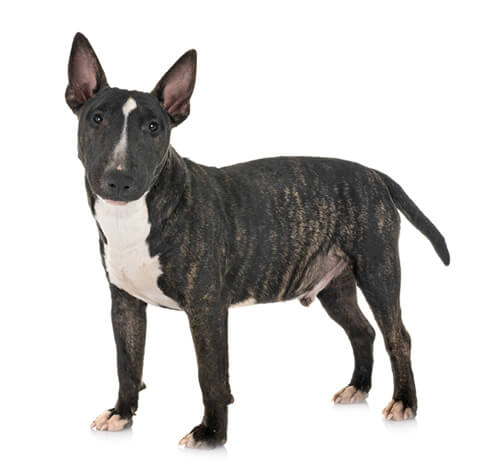
The Miniature Bull Terrier is identical to the Bull Terrier in everything but size, with adults standing at under 35.5cm and weighing about 11-15kg. He is a muscular, powerful-looking dog, with an egg-shaped head. The short coat comes in a variety of combinations, including white, black, brindle, red, fawn and tricolour. See the breed standard for full details.
The need-to-know
- Dog suitable for owners with some experience
- Some training required
- Enjoys active walks
- Enjoys walking an hour a day
- Medium dog
- Minimum drool
- Requires grooming once a week
- Non hypoallergenic breed
- Chatty and vocal dog
- Guard dog. Barks and alerts
- May require training to live with other pets
- May require training to live with kids
Personality

Known for his affinity with people, the Miniature Bull Terrier is full of fun and spirit, though can be stubborn if not properly motivated. He might be smaller than his full-sized counterpart, but this bold, energetic dog doesn't know it! He is a big dog in a small body – and won't be intimidated by larger dogs if confronted. Early, thorough socialisation is especially important, therefore, as is lead training, as he loves to pull!
History and Origins

Small examples of the Bull Terrier were selectively bred from the early 1800s to produce the Miniature Bull Terrier dog breed, a dog used as a ratter as well as a companion. The larger 'Bully' proved more popular, however, and lack of interest in the smaller sized dog by the beginning of the 20th century resulted in it being removed from the Kennel Club breed register in 1918. Thankfully, dedicated breed enthusiasts continued to keep the breed alive and a club was formed in 1938.
Nutrition and Feeding

Your dog's diet needs to have the right balance of all the main nutrient groups including a constant supply of fresh water. It's also important to conduct regular body condition scores to ensure you keep your dog in ideal shape and remember to feed him at least twice daily and in accordance with the feeding guidelines of his particular food.
Exercise

About one hour's exercise per day is required, though the Mini Bull Terrier is capable of much more if you can offer it.
Other Information

Health and common issues
Deafness is the most common health problem within the breed, most frequently encountered in white Bull Terriers. Dogs can be tested for deafness from a young age. Inherited kidney problems, and heart problems can occur, and skin disorders arise relatively frequently.
Best family dog breeds
While many dogs are traditionally thought of as being good with children , all dogs and children need to be taught to get on with and respect each other, and be safe together. Even so, dogs and young children should never be left alone together and adults should supervise all interactions between them.